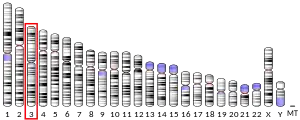CYP8B1
CYP8B1 (cytochrome P450, family 8, subfamily B, polypeptide 1) also known as sterol 12-alpha-hydroxylase is a protein which in humans is encoded by the CYP8B1 gene.[5]
| CYP8B1 | |||||||||||||||||||||||||||||||||||||||||||||||||||
|---|---|---|---|---|---|---|---|---|---|---|---|---|---|---|---|---|---|---|---|---|---|---|---|---|---|---|---|---|---|---|---|---|---|---|---|---|---|---|---|---|---|---|---|---|---|---|---|---|---|---|---|
| Identifiers | |||||||||||||||||||||||||||||||||||||||||||||||||||
| Aliases | CYP8B1, CP8B, CYP12, cytochrome P450 family 8 subfamily B member 1 | ||||||||||||||||||||||||||||||||||||||||||||||||||
| External IDs | OMIM: 602172 MGI: 1338044 HomoloGene: 3233 GeneCards: CYP8B1 | ||||||||||||||||||||||||||||||||||||||||||||||||||
| |||||||||||||||||||||||||||||||||||||||||||||||||||
| |||||||||||||||||||||||||||||||||||||||||||||||||||
| |||||||||||||||||||||||||||||||||||||||||||||||||||
| |||||||||||||||||||||||||||||||||||||||||||||||||||
| Wikidata | |||||||||||||||||||||||||||||||||||||||||||||||||||
| |||||||||||||||||||||||||||||||||||||||||||||||||||
This gene encodes a member of the cytochrome P450 superfamily of enzymes. The cytochrome P450 proteins are monooxygenases which catalyze many reactions involved in drug metabolism and synthesis of cholesterol, steroids and other lipids.
CYP8B1 is an endoplasmic reticulum membrane protein and catalyzes the conversion of 7 alpha-hydroxy-4-cholesten-3-one into 7-alpha,12-alpha-dihydroxy-4-cholesten-3-one. The balance between these two steroids determines the relative amounts of the two primary bile acids, cholic acid and chenodeoxycholic acid, both of which are secreted in the bile. In the intestine these bile acids affect the solubility of cholesterol and other lipids, promoting their absorption.
CYP8B1 is unique among the cytochrome P450 genes in that it is intronless.[6]
The elephant, manatee and naked mole rat have inactive copies of this gene and lack cholic acid in their bile.[7] Relaxed selection resulting from changes in diet to consume less lipids might have contributed to the loss of this gene in several species.[8]
References
- GRCh38: Ensembl release 89: ENSG00000180432 - Ensembl, May 2017
- GRCm38: Ensembl release 89: ENSMUSG00000050445 - Ensembl, May 2017
- "Human PubMed Reference:". National Center for Biotechnology Information, U.S. National Library of Medicine.
- "Mouse PubMed Reference:". National Center for Biotechnology Information, U.S. National Library of Medicine.
- Gåfvels M, Olin M, Chowdhary BP, Raudsepp T, Andersson U, Persson B, Jansson M, Björkhem I, Eggertsen G (March 1999). "Structure and chromosomal assignment of the sterol 12alpha-hydroxylase gene (CYP8B1) in human and mouse: eukaryotic cytochrome P-450 gene devoid of introns". Genomics. 56 (2): 184–96. doi:10.1006/geno.1998.5606. PMID 10051404.
- "Entrez Gene: CYP8B1".
- Sharma, V; Hiller, M (1 December 2018). "Loss of Enzymes in the Bile Acid Synthesis Pathway Explains Differences in Bile Composition among Mammals". Genome Biology and Evolution. 10 (12): 3211–3217. doi:10.1093/gbe/evy243. PMC 6296402. PMID 30388264.
- Shinde, SS; Teekas, L; Sharma, S; Vijay, N (September 2019). "Signatures of Relaxed Selection in the CYP8B1 Gene of Birds and Mammals". Journal of Molecular Evolution. 87 (7–8): 209–220. Bibcode:2019JMolE..87..209S. doi:10.1007/s00239-019-09903-6. PMID 31372666. S2CID 199380339.
Further reading
- Li Y, Mezei O, Shay NF (2007). "Human and murine hepatic sterol-12-alpha-hydroxylase and other xenobiotic metabolism mRNA are upregulated by soy isoflavones". J. Nutr. 137 (7): 1705–12. doi:10.1093/jn/137.7.1705. PMID 17585019.
- Yang Y, Eggertsen G, Gåffvels M, et al. (2004). "Mechanisms of cholesterol and sterol regulatory element binding protein regulation of the sterol 12alpha-hydroxylase gene (CYP8B1)". Biochem. Biophys. Res. Commun. 320 (4): 1204–10. doi:10.1016/j.bbrc.2004.06.069. PMID 15249218.
- Gerhard DS, Wagner L, Feingold EA, et al. (2004). "The status, quality, and expansion of the NIH full-length cDNA project: the Mammalian Gene Collection (MGC)". Genome Res. 14 (10B): 2121–7. doi:10.1101/gr.2596504. PMC 528928. PMID 15489334.
- Ellis EC (2006). "Suppression of bile acid synthesis by thyroid hormone in primary human hepatocytes". World J. Gastroenterol. 12 (29): 4640–5. doi:10.3748/wjg.v12.i29.4640. PMC 4087826. PMID 16937432.
- Wang J, Greene S, Eriksson LC, et al. (2005). "Human sterol 12a-hydroxylase (CYP8B1) is mainly expressed in hepatocytes in a homogenous pattern". Histochem. Cell Biol. 123 (4–5): 441–6. doi:10.1007/s00418-005-0779-0. PMID 15891895. S2CID 12069227.
- Strausberg RL, Feingold EA, Grouse LH, et al. (2002). "Generation and initial analysis of more than 15,000 full-length human and mouse cDNA sequences". Proc. Natl. Acad. Sci. U.S.A. 99 (26): 16899–903. Bibcode:2002PNAS...9916899M. doi:10.1073/pnas.242603899. PMC 139241. PMID 12477932.
- Nelson DR, Zeldin DC, Hoffman SM, et al. (2004). "Comparison of cytochrome P450 (CYP) genes from the mouse and human genomes, including nomenclature recommendations for genes, pseudogenes and alternative-splice variants". Pharmacogenetics. 14 (1): 1–18. doi:10.1097/00008571-200401000-00001. PMID 15128046.
- Ross CJ, Katzov-Eckert H, Dubé MP, et al. (2009). "Genetic variants in TPMT and COMT are associated with hearing loss in children receiving cisplatin chemotherapy". Nat. Genet. 41 (12): 1345–9. doi:10.1038/ng.478. PMID 19898482. S2CID 21293339.
- Lu Y, Dollé ME, Imholz S, et al. (2008). "Multiple genetic variants along candidate pathways influence plasma high-density lipoprotein cholesterol concentrations". J. Lipid Res. 49 (12): 2582–9. doi:10.1194/jlr.M800232-JLR200. PMID 18660489.
- Zhang M, Chiang JY (2001). "Transcriptional regulation of the human sterol 12alpha-hydroxylase gene (CYP8B1): roles of heaptocyte nuclear factor 4alpha in mediating bile acid repression". J. Biol. Chem. 276 (45): 41690–9. doi:10.1074/jbc.M105117200. PMID 11535594.
This article incorporates text from the United States National Library of Medicine, which is in the public domain.



